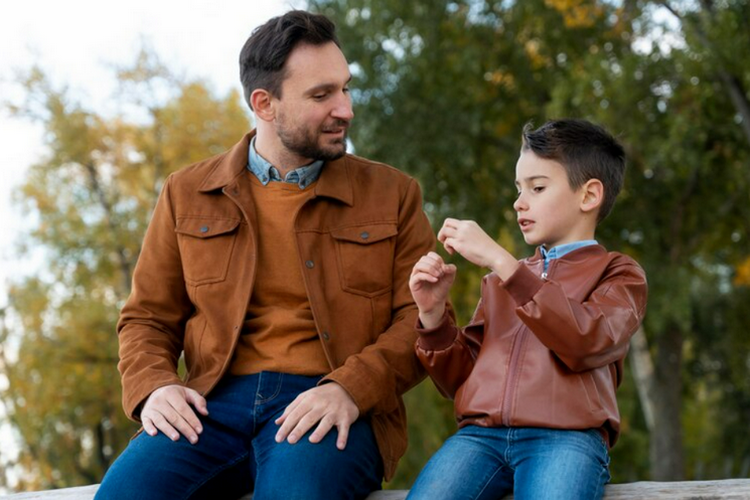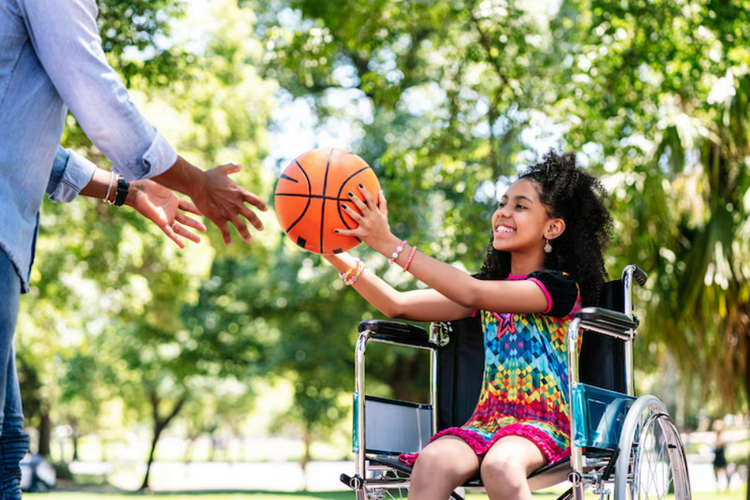


Have you ever been in a situation where your child sees a disabled person and asks, “What’s wrong with that person?” If so, how did you respond? Situations like that seeing special needs children or a disabled person can be both embarrassing and tricky. How do you handle your kids talking about disabilities? You think, what do I say? Did the person hear? Do I answer with a guess about the person? Do I ignore the question? How do I, at that moment, teach my child a valuable lesson when meeting children with special needs or a disabled person?
Let’s start with these questions. We might want to postpone answering them until we address the question itself and how it’s asked. Although we hear these words often and are accustomed to them in our society (unfortunately), our answers, if given immediately without addressing the words chosen, can only lead our children in one direction.
And that direction might be one we actually don’t want to follow. If you attempt to answer what’s wrong with that person…you are affirming that something is wrong with that disabled person. Maybe that can be changed. What does this mean? It means that if we allow the words what’s wrong with that person to lead us in our responses, then we accidentally teach that something is wrong.
Having special needs children or disabilities shouldn’t be looked upon as something wrong or abnormal. It’s time to change the inadvertent tendency to affirm that having children with special needs makes something about the person “wrong.”
That change can come in the form of gentle guidance or careful correction. The question itself comes from curiosity, as children are naturally curious about those around them. ReWORDing the question for the child is a great place to start talking about disabilities. While respecting that the original question was asked, again because the child is curious, a parent or caregiver can say, “Oh, do you mean to ask me why someone seems different from you or me?” Then from the beginning of your conversation, you as the parent have “tweaked” the intangible implication of something being wrong. This subtle shift can guide the rest of the conversation in a much more positive direction.

Another rephrasing might be, “Oh, you notice that someone is doing something different from what you are doing.” This question may pop up when your child observes children with special needs flapping their hands or spinning objects or perhaps facing a sensory challenge. Again, rewording the question gently to avoid scolding or criticizing can put the ensuing conversation on a different course.
So after the question gets reworded and the conversation proceeds, a parent or caregiver has the responsibility to address the question when talking about disabilities to your kids. It might be wise to have a reply planned ahead. And when thinking about that reply, here are some things to keep in mind:
1. Things that appear different are not “bad;” they’re just different.
2. Curiosity deserves to be validated with positive statements.
3. Responses to a child’s question begin to form the child’s perspectives.
4. Emphasizing similarities in the face of differences builds connection.
5. A straightforward, simple approach without judgments serves the child well, as well as the disabled person.
Keeping these ideas in mind when you provide a reply when talking about disabilities (whether or not that leads to a longer conversation) can help steer your response in a positive direction. Realize that ignoring the child’s question sends a message that it’s not worth paying attention to; also, telling your child to “just ignore” the special needs children or a disabled person teaches them that person doesn’t matter.
It shouldn’t be “just move along honey” or “stop looking at them.” What if you took the opportunity to foster understanding, compassion, and inclusion? Your reply has the power to do that.

As a casual conversation when talking about disabilities forms, a good starting point might be, “Some people are born with disabilities, and some people become disabled in an accident.” You can introduce a more generic approach that takes the spotlight off the person your child sees. Then, you are not passing judgment, making guesses, or risking hurt feelings.
Let’s say your child sees another child in a wheelchair. She asks, “What’s wrong with her, Mommy?” You can respond, “Oh, you see a person using a wheelchair. Do you want to ask me about people in wheelchairs?”
Try to find something your child can connect to and see as positive. It could be as simple as “She’s wearing a blue shirt, and so are you!” If your child asks a why question, be straightforward and simple: “Some people who use wheelchairs have a disability, or they might have been injured.”
If the circumstances allow it, you could also consider striking up a conversation with the person your child noticed. “My daughter was curious about your wheelchair, can you tell us about it?” With courteous introductions, you never know what positive interactions open up to you and your child.

It’s natural for us to witness different appearances and behaviors and decide for ourselves what’s causing them. The truth is, we don’t really know. Individuals with autism can exhibit behaviors that look unusual, especially to young children. From the outside, it may look like a boy behaving badly. But unless we truly know what’s going on, we can’t just tell our kids that it’s a boy behaving badly.
Validate your child’s curiosity, reword that why is he acting that way question, and work around the emotion and judgment that likes to creep in. If your child sees a boy or girl jumping vigorously in line at Target and making loud noises, what would you do? You anticipate the question as your son or daughter looks curiously in that direction.
“What’s wrong with that boy, Mommy? Why is he acting that way?” The boy’s dad flashes a look in your direction.
“Oh, you see someone behaving a little differently in line than you do.”
“Yeah, why is he behaving like that, Mommy?”
“Why is the boy in line jumping? I’m not sure. Maybe he’s excited to buy something. He has blue shoes on. Maybe he likes them. Do you like his blue shoes?” The dad then flashes a smile in your direction.
Think about how differently that moment would go if you said, “I don’t know. Just ignore him.” Or, “Shhh. Don’t ask questions like that.” Or, “He’s behaving badly right now. Don’t stare.” The boy who is jumping might have heard your comments. The dad might have taken offense. And your child might feel shut down for her curiosity.
A lesson about respect, understanding, and inclusion wouldn’t have happened. Turning that around just takes a bit of forethought.
It’s not our fault; we are often caught off guard by such questions. We often don’t preplan our responses. Embarrassment can tongue-tie us or make us say things we wish we hadn’t said. It’s A-OK to help your child form (or re-form) questions and use that as your starting point. Initiate conversation with the person your child has asked about (or the parents). Include them and allow them to answer for themselves rather than talking about them in front of them.
When you approach potentially uncomfortable situations with an open mind, with curiosity and positivity at the forefront, and with connection as a goal, you can go beyond teaching tolerance. You can achieve acceptance. Empathy. Mutual respect. Growth.
We change the conversation to one where the thoughts and feelings of the “asker” and the “askee” are acknowledged and appreciated. A parent’s response to a child’s questions about perceived disabilities will affect how the child thinks about disability and treats others with disabilities.
For additional information on talking about disabilities with your child, see this LINK. You can also visit our Special Needs Category for more resources.
Read other blogs by Keri Horon HERE and HERE
Just enter your email address below and you’ll get an email every time we publish a new post!
Categories :
Tags :
Keri is a special needs parent and a veteran high school English and journalism teacher turned writer. She enjoys reading, hiking, gardening, cooking, traveling, wine tasting, and practicing yoga. Both she and her son love to create art. She has a passion for educating people on all things autism. Visit her blog at https://kerimehome.com.
View All PostsNotifications